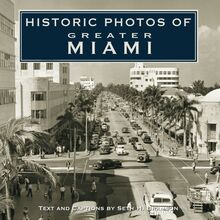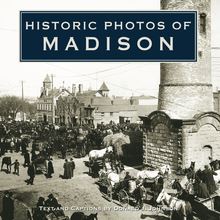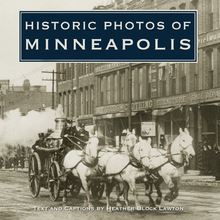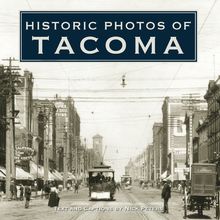Historic Photos of St. Paul , livre ebook
198
pages
English
Ebooks
2008
Vous pourrez modifier la taille du texte de cet ouvrage
Obtenez un accès à la bibliothèque pour le consulter en ligne En savoir plus
Découvre YouScribe en t'inscrivant gratuitement
Découvre YouScribe en t'inscrivant gratuitement
198
pages
English
Ebooks
2008
Vous pourrez modifier la taille du texte de cet ouvrage
Obtenez un accès à la bibliothèque pour le consulter en ligne En savoir plus
Publié par
Date de parution
01 juin 2008
Nombre de lectures
2
EAN13
9781618586834
Langue
English
Poids de l'ouvrage
9 Mo
Publié par
Date de parution
01 juin 2008
Nombre de lectures
2
EAN13
9781618586834
Langue
English
Poids de l'ouvrage
9 Mo
HISTORIC PHOTOS OF
ST. PAUL
T EXT AND C APTIONS BY S TEVE T RIMBLE
There were several railroad suburbs in St. Paul in the 1880s. Highwood was built in the far southern part of the city and was promoted as an area of exclusive homes built into tree-filled hills. In 1887, trains ran to this depot six times a day going to and from downtown, but the project collapsed during the 1893 depression.
HISTORIC PHOTOS OF
ST. PAUL
Turner Publishing Company
200 4th Avenue North Suite 950
Nashville, Tennessee 37219
(615) 255-2665
www.turnerpublishing.com
Historic Photos of St. Paul
Copyright 2008 Turner Publishing Company
All rights reserved.
This book or any part thereof may not be reproduced or transmitted in any form or by any means, electronic or mechanical, including photocopying, recording, or by any information storage and retrieval system, without permission in writing from the publisher.
Library of Congress Control Number: 2007929567
ISBN: 978-1-59652-395-1
Printed in China
09 10 11 12 13 14 15 16-0 9 8 7 6 5 4 3
C ONTENTS
A CKNOWLEDGMENTS
P REFACE
T HE R IVER C ITY (1840-1869)
T HE C ITY ON R AILS (1870-1918)
T HE C ITY IN T RANSITION (1919-1945)
T HE M ODERN M ETROPOLIS (1946-1970 S )
N OTES ON THE P HOTOGRAPHS
When it started in the 1860s, it was called St. Paul High School. As the population grew and other institutions were added, it became Central High School, because of its downtown location. This Tenth and Minnesota image was taken in 1892. Central is now housed in a different building at the corner of Lexington and Marshall.
A CKNOWLEDGMENTS
This volume, Historic Photos of St. Paul , is the result of the cooperation and efforts of many individuals and organizations. It is with great thanks that we acknowledge the valuable contribution of the following for their generous support:
Minnesota State Historical Society
Ramsey County Historical Society
Thanks in particular to Maureen McGinn of the Ramsey County Historical Society and Debbie Miller and Tracey Baker of the Minnesota Historical Society.
-------
For Richard C. Wade
who helped so many of us
to understand the importance
of urban history .
P REFACE
With Minnesota celebrating its sesquicentennial, 2008 seems an appropriate time to reflect on St. Paul s past. But what is the best way to tell its story? The city has constantly changed, has grown, moves outward, is home to a shifting population. New institutions take the place of old. Using mostly photographs to tell the story of St. Paul could seem a little problematic. After all, historians write at length about the past while photographers capture only moments, frozen in a snapshot.
People often say the camera doesn t lie, but a bias often hides in images just as it hides in words. Photographers choose what images to produce. The people, events, and city scenes are filtered through their subjective values-what to shoot, how to frame it, when to take it, and, perhaps just as important, what to leave unrecorded. Photos of accomplishments are far more common than those of failures.
It is also said that a picture is worth a thousand words, but again this is only partly true. Even wonderful images can be more helpful in understanding the past when a narrative is added. There is always a story that accompanies a photograph. The two boys shown boxing in this book, it turns out, were going to be part of an open house for Christ Child Center.
Without visual images, however, it would ultimately be far more difficult to understand the history of St. Paul. Letters and diaries may mention houses, the river landing, or crowded streets and neighborhoods, but images give an important sense of how the city looked and was once arranged.
The selections in this book may show some sort of bias. Telling the city s story with two hundred photos is difficult, so choices had to be made. Historical societies mostly preserve photographs that have been donated haphazardly, so sometimes it is impossible to find images to illustrate particular aspects of urban life. With the addition of introductions and captions, however, the effort has been made to present a balanced perspective on one of the nation s great cities.
This volume has been divided into four sections. Its first, The River City, starts in the 1840s when St. Paul was a frontier outpost and continues through 1869, when it had established itself as an important Midwest commercial center. The city relied heavily on the river trade and when the Mississippi was frozen, St. Paul was a very isolated place to be.
The City on Rails, the second section, stretches from 1870 to 1918 and looks at an era generally characterized by a booming economy. It was a time when new forms of transportation were the key factor in determining the shape and direction of the city and its people. The railroad was a large employer that linked St. Paul with the rest of the nation. Streetcars aided the city s outward spread, helping create ethnically and economically diverse neighborhoods. The city expanded and needed new infrastructure, investing in roads, sidewalks, sewers, streetlights, and a grand park system.
The period from 1919 to 1945, called The City in Transition, highlights events from the beginning of one world war to the end of another. The economy boomed and busted and boomed again, causing cultural shifts. The automobile, movies, and radio had a strong impact on St. Paul. Autos allowed people to live in areas not served by streetcars, so housing and new neighborhoods developed. But during the Great Depression of the 1930s almost all construction came to a halt that lasted through World War II.
The Modern Metropolis is the last era. Starting in 1946, it takes St. Paul through to the turbulent 1960s and 1970s. Cars had an increasing impact and the city was linked nationally by truck and air transportation. The freeways cut into communities and, in the case of the Rondo neighborhood, destroyed one. There were urban renewal projects, old buildings came down, and public housing went up. Starting in the 1970s, new immigrant groups seeking a better life came to St. Paul from Central America, Asia, Africa, and elsewhere. People from rural areas in the Midwest migrated to the city, along with large numbers of African Americans from various parts of the nation.
Although no single volume can tell the complete story of St. Paul, it is hoped that these photographs and accompanying narratives provide a good glimpse of its people and the city s growth over the last century and a half.
-Steve Trimble
Engebreth H. Hobe in his 315 Jackson Street office around 1904. Hobe settled in St. Paul in 1883 and successfully engaged in the real estate business in the city and other states, as well as Norway. He served as Norwegian consul in St. Paul from 1893 to 1940 and had connections with the Norwegian America Steamship Line.
T HE R IVER C ITY
(1840-1869)
St. Paul was part of an urban frontier and was an important economic and cultural force even before Minnesota became a state. Its settlement began in the late 1830s, when squatters were driven away from Fort Snelling and went east to a place then known as Pig s Eye. Because a waterfall a few miles upriver made further travel on the Mississippi nearly impossible, St. Paul, as it was later named, was bound to thrive because it had the nearest landing for steamboats.
When Minnesota became a Territory in 1849, St. Paul was its capital, and there was a rush of settlers to the area. The population swelled from a handful to nearly a thousand and it was a sizable town even before many farmers were claiming land in the area.
St. Paul was isolated when the river froze, but people pulled together and thrived. Ponds were drained, hills graded away, and streets laid out. The city established basic services including water and gas. The Wabasha Bridge, built in 1858, helped the city expand across the Mississippi.
The city was new, but boasted amenities. Most residents had lived in urban areas and knew what a city should be like. Those from New England and the Midwest wanted to plant a Yankee culture and quickly passed laws for civic betterment and social control. Along with the native-born, German, Irish, French Canadian, and other immigrants built churches and music halls, and started fraternal groups and clubs. Visitors were astounded by St. Paul s rapid growth and often remarked on the number of languages heard on the sidewalks.
The fur trade, lumbering, and agriculture were the mainstays of the early economy. Most people worked in small shops, and farmers brought produce into the city market or hawked on the streets. In the winter, people relied on what they had preserved, or purchased staples from small stores.
The aspirations and concerns of the early urban dwellers were similar to those expressed today. They worried about crime, public health, the education of children, the need for housing, the quality of city services, and what to do with the poor. They took pride in the progress of their new metropolis on the Mississippi.
Fort Snelling was built on a high bluff at the junction of the Mississippi and Minnesota rivers in the 1820s. This military outpost would have a close connection with St. Paul. Former soldiers, squatters, and traders ended up moving eastward to the new settlement of Pig s Eye, as the city was originally known. This view is from the ferry landing on the east side of the river.
Geography determined St. Paul s location. Steamboats could not go beyond St. Anthony Falls a few miles upriver. This early photograph illustrates the break in the high bluffs along the Mississippi and its gradual slope, which was ideal for loading and unloading people and merchandise. The site was well suited for the founding of an important commercial city.
Frontier St. Paul was full of small frame houses, piles of wood for heating, and at least one tree in 1851. This image shows the First Baptist Church














